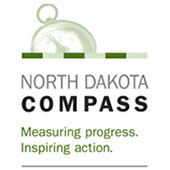Ask A Researcher
March 2015
Tell a Story with Data! The Importance of Cradle-to-Career Success

North Dakota Compass website sets a standard for unbiased, up-to-date, and credible data and information. Moreover, by presenting data in a variety of topics that define quality of life it provides a broader picture and can offer solutions to complex issues. In this article, the North Dakota Compass team illustrates the impact of an increasingly diverse population as they develop and enter adulthood and the workforce. Understanding trends in the child population helps us plan for and improve student development, learning, and accomplishments, and ultimately, the future. An investment in North Dakota’s young children is an investment in the future economy and workforce of the state. The more we know about our children, the better equipped we are to make smart investments in our future.
North Dakota’s energy development, robust economy, and thriving workforce are reinvigorating the state’s population. For the third year in a row, North Dakota continues to be the fastest growing state in the nation with the population reaching a total of 739,482 residents in 2014. This growing population also has seen a decline in median age (35.3 years, 2013), which means the state’s population is getting younger.
Beyond seeing a younger demographic coming into the state’s communities, North Dakota is also becoming more racially diverse. The North Dakota population of color (i.e., non-white) experienced a 24 percent increase from 2010 to 2013. During the same time period, when comparing racial/ethnic groups, the Black population experienced the fastest growth (59% increase), followed closely by the Hispanic population (54% increase). Native Americans continue to make up the largest minority population in North Dakota (39,395 residents in 2013). Taking a closer look at breakdowns, North Dakota is seeing similar trends in the racial breakdown of children.
The dynamic nature of this population shift creates a variety of opportunities for North Dakota communities. Understanding trends in the child population helps communities plan for and improve schools, student learning and accomplishments, and ultimately, the future. An investment in young children is an investment in the future economy and workforce of the state. The more we know about children, the better equipped we are to make smart investments in the future.
Building a pathway to success begins early in life, and must provide opportunities for all children and youth. Educational experiences and opportunities (e.g., optimal health, preschool enrollment, and college attendance) are very significant as they compound throughout an individual’s life and when they enter into the workforce and start contributing to the economy and community. In North Dakota, there are large racial gaps along the cradle-to-career continuum. Given the increase in North Dakota’s diversity with its growing population, these disparities will increase unless they are addressed. Starting at birth, North Dakota ranked well at 4th best (tied with 3 other states) in the nation with 6 percent of all births being low birth weight in 2013. However, as children continue to grow and lay the foundation for their future education, North Dakota falls to 42nd best in the nation in the percentage of 3- and 4-year olds who are enrolled in preschool (2013). In North Dakota, 39 percent of 3- and 4-year olds are enrolled in preschool compared to 46 percent nationally.
In 2014, 77 percent of all North Dakota third graders met or exceeded third grade reading standards, but the proportion drops to 63 percent for Black third graders, 58 percent for Hispanic students, and 59 percent for Native American students. In middle school, 66 percent of all North Dakota eighth graders met or exceeded eighth grade math standards; however, this proportion drops to 42 percent for Black eighth graders, 39 percent for Hispanic students, and 38 percent for Native American students in 2014. When taking a look at 2013 graduation rates, 87 percent of the state’s high school students graduated on time. Looking specifically at racial and ethnic groups, 80 percent of Black and 78 percent of Hispanic high school students graduated on time; however, only 61 percent of Native Americans high school students graduated on time. On a positive note, when looking at student successes, compared to 2008, Hispanic high school students in 2013 showed a 12 percentage point increase in on time graduation.
After high school, many young adults continue on with their education and achieve a postsecondary degree, which is one key to a vibrant and successful workforce. In 2011, North Dakota ranked 37th best in the nation for a 6-year graduation rate at a 4-year institution (49% completed their “4 year degree” within 6 years). Again, we continue to see racial gaps, where 28 percent of Black college students, 31 percent of Hispanic students, and 12 percent of Native American students completed their “4 year degree” within 6 years.
North Dakota ranked 26th best in the nation for percentage of adults, age 25-34 (31%), and 31st best for percentage of adults, age 25 and older (27%), with a bachelor’s degree or higher in 2013. Again, we continue to see racial gaps, where 28 percent of Black adults (age 25 and older), 15 percent of Hispanic adults, and 14 percent of Native American adults have a bachelor’s degree or higher.
Education of the future workforce is important, because by 2018, 70 percent of all jobs in North Dakota are expected to require a postsecondary education, according to the Georgetown University Center on Education and the Workforce. Research also suggests that individuals with higher levels of education are better able to compete for high quality jobs and more likely to obtain jobs with better working conditions, benefits, and opportunities for advancement.
These data, accompanied by other key measures from the North Dakota Compass website along the birth through adult life spectrum help to anticipate and address the needs of North Dakota’s children - the future workforce, future community leaders and policy makers.
